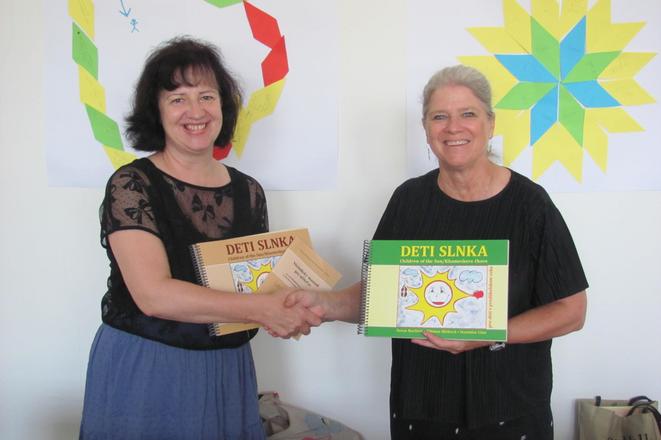Barfield worked with Bibiána Hlebová and Roma Language teacher Stanislav Cina, both of the Faculty of Education at University of Prešov, on the project. With support from the University of Prešov, US Embassy in Slovakia, US Fulbright Commission, and the Slovak Academic Information Agency, the books are now being distributed to Slovak classrooms and children’s libraries to encourage international cultural understanding and tolerance.
The Slovak Spectator spoke with Barfield about the project.
The Slovak Spectator: Why did you decide to write a trilingual book for Roma children in Slovakia?
Susan Barfield: I have worked with US Native American students, which is the largest minority population in Montana, for almost 20 years and for two years have studied Roma educational issues off and on in Slovakia, Slovenia and Turkey. Many of the Roma student educational issues are the same as those of Native American students in Montana: high absenteeism, higher dropout rates, poor academic skills, significant cultural differences, and lower socio-economic status, often severe poverty. Most Roma are not socially accepted by the majority Slovak culture. Few Roma teachers are in the schools and many Roma parents have had such negative experiences in school that they are reluctant to send their children or cooperate with schools. Perhaps seeing their culture represented positively in Slovak schools would encourage stronger ties between the school and the Roma home. Having young Roma children see their language in print and their folktales included in the curricula might stimulate school participation. Talking about Roma culture in Slovak classrooms could help teach cultural tolerance and respect. Why a tri-lingual book? Having three languages represented allows students to experience multiple cultures within one educational element.
TSS: The story is based on a Roma folktale, how did children respond to the book?
SB: The books are just being disseminated; however, during development we read the books to several Roma classrooms and asked students to illustrate the story. Using student illustrations is what makes these books unique; again, they put the Roma culture in a more positive light and allow Roma children to see their input into education in the classroom. At the official Book Launch on International Roma Day in April 2015 at the Children’s Library in Prešov, students acted out the story with music and dance. The student illustrators were very proud when their work was acknowledged!
TSS: How do the Slovak teachers you have worked with, see the book?
SB: We received feedback from teachers in the classrooms where we read the story and had students illustrate it. It was their suggestion to create the preschool version of the book as the original primary book was too long and comprehensive for kindergarten students’ attention spans and vocabularies. We just completed our first teachers’ workshop on how to integrate the books into the classroom in early July. Thirteen teachers from the Prešov area attended the four-day workshop. The presenters were the three authors of the books, each representing one of the cultures. In addition to learning about the importance of Roma identity and socio-emotional impact on young children, participants in the workshop experienced eight activities to use the books in their classrooms, including how to create an e-Book. Workshop evaluations indicated that participants were extremely satisfied with the workshop and many hoped another workshop would be available in the future.
TSS: What have you learned about Slovak Roma and teachers while doing this project?
SB: I have learned a great deal. First, it is important not to generalise about any culture; there is no generic Roma. I met Roma families who are working and value education. I met those who want to work, are unable to find a job, and want to return to school. And I met families who are not interested in Slovak education. At the same time, I visited communities where schools were segregated and other villages where Roma and Slovak students attended school together. Second, I am in awe of Slovak teachers who face difficult situations in their schools and yet continue to work with their students and their students’ parents. I was impressed with the quality of professionalism of these teachers and their commitment to overcome many of the challenges of working with Roma children, parents, and communities. I would love to see more Roma students finish school, attend universities, and even become teachers themselves. These books and the concept of integrating Roma culture into Slovak classrooms are but a tiny “seed.” It will take many more elements in the Slovak school system and many years to nurture that seed.


 Bibiána Hlebová (left) and Susan Barfield (right) (source: Susan Barfield archive)
Bibiána Hlebová (left) and Susan Barfield (right) (source: Susan Barfield archive)